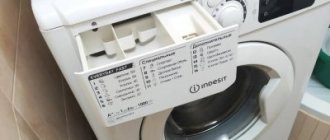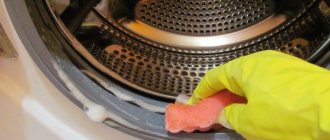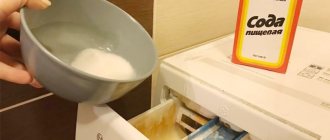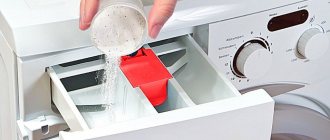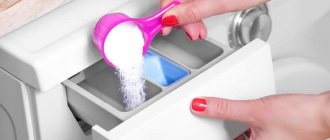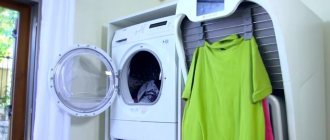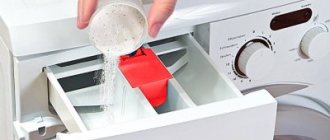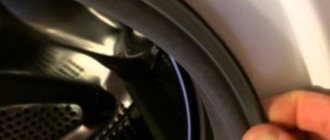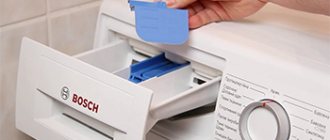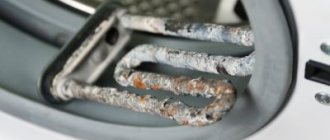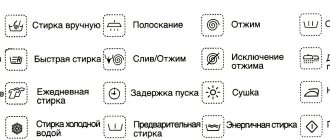An indispensable assistant for modern housewives is an automatic washing machine. It makes our life much easier, but sometimes it requires special care. Like any household appliance, the washing machine must be kept clean, otherwise the device will not be able to work at full capacity or will stop working altogether. One of the unpleasant surprises that we encounter during the operation of a washing machine is contamination of the powder and conditioner compartments. How and with what they can be cleaned, we will consider in this article.
Does the container need to be cleaned?
Careful operation and proper maintenance are important for any equipment. Automatic cars are no exception. Only if you follow the manufacturer's recommendations and regular cleaning will the device last a long time.
The powder tray is not the most important part of the device. There is no need to clean the dispenser. Many users think so. They are confident that the strong water pressure when starting the program effectively washes out the detergents. This is wrong. Almost always, residues settle on the walls of the container. There are two reasons for this:
- Low-quality powder (the worse the detergent, the more of it will remain on the walls).
- Weak water pressure in the riser greatly increases the likelihood of poor rinsing of the product from the container.
Ditch bleaches and conditioners are truly evil. Such chemistry settles on the sides of the tray in the form of a sticky and slippery film, which hardens over time.
This causes blockages. They can lead to equipment breakdown and failure.
If a serious breakdown occurs and the repairman says that the reason for this is contamination of the detergent container, it will be very insulting and annoying.
It is important to figure out how to properly clean the powder compartment and how to wash the cuvette?
Why is it necessary to clean the powder compartment?
Cleaning the powder reservoir is a necessary procedure. It is a mistake to believe that during the washing period, detergent compounds are washed out of the compartment with water and do not accumulate inside it. In fact, some of these substances settle in the washing machine and require cleaning measures, since the resulting lime deposits and residues of household chemicals interfere with the water supply during automatic washing due to the closure of a special hole. As a result, the powder does not get inside the machine and does not participate in the wash, so it is ineffective. Often such carelessness on the part of the housewife leads to the breakdown of household appliances.
Dirt and mold deposits in the powder receptacle will inevitably end up in the laundry drum. Things will be dirty, and in the best case they will have to be rewashed, in the worst case the clothes will be ruined.
How to clean the dispenser mechanically
The MCA cuvette is the dirty part of the device. The only dirtier things are the tank, hoses and pipes. It is very difficult to get them out and wash them properly. Cleaning the container is not difficult. He is always in sight.
Often the machine stops working normally when powder is clogged in the container. You invite a specialist to your home to carry out repairs. He doesn't fix anything. Simply wash the dispenser and the device functions again without any problems. The specialist leaves and charges a lot of money for the visit and a basic procedure. It's a shame? Undoubtedly! You could read on the Internet how to remove the powder and deal with the problem yourself.
To avoid troubles, make it a rule to clean the compartment every 2-3 washes. Some users do not know how to remove the container. It couldn't be easier to do this. Most machines from different manufacturers are equipped with a simple straight dispenser with a locking tongue. Press down and slightly pull the device towards you. The cuvette will come out quickly and easily.
There are very few SMAs with non-standard trays. They are all well known. These are Indesit and Ariston.
Some models of vertical machines have a compartment built into the body. Taking the tray out of them for the first time is not easy, but it is possible. The main thing is to get used to it and understand the principle by studying the video instructions in detail on the Internet.
The easiest way to remove unnecessary contaminants from a container is mechanically. You need to do this:
- Remove the container and rinse thoroughly with hot water.
- Simply rub it with a hard sponge or brush. This way you can remove particles of dried detergent and sticky residue.
- Rinse the container thoroughly under the tap and wipe dry.
This method without soaking and using chemicals is suitable if the cuvette is not very dirty.
There is no need to use overly hard brushes. There are special marks on the surface of the dispensers that are easily erased when exposed to particularly hard surfaces.
The fastest way to clean the tray
If the contamination is not too strong, a quick rinse of the tray under hot water will help. Stages of the procedure:
- take out the container;
- remove all removable elements of the powder receiver;
- rinse all parts under running hot water; if stains are not washed off, remove them with a sponge;
- wipe the inside of the machine where the reservoir was located with a damp cloth;
- connect all structural elements and insert the tray into place.
How to clean powder from a washing machine: chemicals to help
We figured out how to wash powder in a tray with light dirt. It may happen that mechanical cleaning was unsuccessful. Contaminants in the form of old detergent, plaque, and mucus remain in the compartment.
What to do in this case? How to dissolve hardened laundry detergent and stubborn dirt? There is only one way out - use the right chemistry. With its help, you can tidy up the dispenser, as well as the insides of the washing machine. Great, because other parts also need cleaning.
Follow the instructions:
- Open the detergent compartment and add the amount of chemical recommended by the manufacturer. Do not exceed the norm so that the parts do not break.
- Remove things from the drum and turn the SMA to “idle” at a maximum temperature of 90–95 degrees.
- Restart the rinse cycle.
Cleaning the tray and machine is finished!
This method has its drawbacks. The main one is that it does not allow you to remove old dirt and completely clean a very dirty compartment.
Why does dirt appear in the machine compartments?
The washing machine constantly interacts with water, but this does not save its elements from some troubles:
- due to constant dampness, mold may appear in the machine;
- Hard water causes limescale to form on the surfaces of the washing machine;
- Particles of powder or conditioner are retained in the “pockets” for detergents.
All these contaminants negatively affect washing: things are not rinsed and acquire a musty smell. Dirt and mold from the tray get into the drum, which means they affect the operation of the entire mechanism as a whole. Therefore, it is necessary to clean these sections in a timely manner and prevent the reappearance of dirt.
Combined cleaning
Is water not getting into the compartment? The cuvette is completely clogged. Cleaning with chemicals will not work. Mixed cleaning will help. It goes like this:
- Pull out the device and soak it in a basin in water for 5 minutes (water temperature - at least 60 degrees).
- Add or pour chemical into the water and mix well.
- Let the dispenser sit in the solution for several hours.
- Remove the container and scrub vigorously with a brush.
- Rinse, dry and reinstall.
Types of contamination of the detergent tray and reasons
As a result of using the washing machine, the detergent container gets dirty. A rough coating forms inside the compartments, and the plastic gradually turns yellow. In rarely used niches, a fungus multiplies, which can stain things and spread to other parts of the SMA.
Expert opinion
I work in the household appliance repair industry. Extensive experience in restoring washing machines and dishwashers.
Ask a Question
If the washing powder is of poor quality, it dissolves poorly, and its particles remain on the walls of the tray, they gradually accumulate, forming a persistent coating.
Removing the tray
As a result of constant contact with moisture in the washing machine, conditions are favorable for the proliferation of living microorganisms - bacteria and fungi. They can migrate to other parts of the device and cause failure of spare parts.
The rinse aid compartment collects sticky softener particles. They create a favorable environment for mold growth.
Expert opinion
I work in the household appliance repair industry. Extensive experience in restoring washing machines and dishwashers.
Ask a Question
Important! All substances that accumulate in the tray, albeit in small quantities, come into contact with things during washing and remain deep in the fibers of the fabrics.
Limescale
Water consists of a wide variety of mineral components.
The washing machine is constantly in contact with it. As a result, a solid substance consisting of minerals is formed on the parts. Their excessive accumulation affects the functionality of the device.
Plaque particles can stain clothes during washing. Therefore, if present, it must be removed.
Hardened powder
The tray regularly comes into contact with detergents, the composition of which includes many components.
Some of them have the ability to accumulate and create a single solid substance similar in structure to lime deposits. Getting rid of accumulated powder is not as easy as it might seem. It will take some effort.
Detergent tray
Rust
If the water contains a high iron content, when it dries, it oxidizes, which leads to the formation of rust. The particles bind together and remain on the surface. The presence of rust not only affects the aesthetic component of the device. She can get things dirty.
You can get rid of corrosion in the powder tray using hydrogen peroxide mixed with vinegar, salt and ammonia.
- All components are mixed in equal quantities.
- Then the mixture must be heated in a water bath and applied to contaminated areas.
- Leave for 20 minutes and remove rust with a sponge.
Fungus or mold
As a result of regular contact with moisture, the detergent container provides a favorable environment for the life and reproduction of fungi and bacteria. The presence of mold can be easily determined by a greenish-grayish coating that cannot be removed by chemical means.
Acids kill fungi. Therefore, they can be easily dealt with with lemon or vinegar.
What to clean: the best products
We have decided how to combat pollution. Now let’s find out what is the best way to wash fossilized washing powder. Use factory-made household chemicals. It will bring the cuvette and the main components of the unit into proper shape.
The most popular means:
- Frisch Activ. An effective remedy in the fight to keep the dispenser clean. Suitable for trays with light soiling.
- "Doctor TEN." Recommended for dry cleaning of the washing machine and dispenser. Also used for minor stains.
- Sandokkaebi. The most effective composition of South Korean production. It cleans not only the container, but also the hoses and pipes of the SMA. An important advantage is the affordable price.
For soaking the tray, you can use more aggressive chemicals, because it is not poured into the machine. Suitable products for cleaning plumbing fixtures and toilets. For example, “Domestos” or “Toilet duckling”.
Household chemicals
The compositions, which are sold in all hardware stores, can easily cope with contamination of the powder tray. The most accessible and effective are:
- White;
- comet;
- Cif cream;
- Cillit Bang;
- Domestos;
- Toilet duck.
If there are lime deposits, heavy dirt and a musty smell, special products will help, the use of which does not require removing the tray and its elements. Compositions such as Sandokkaebi, Bork K8P, Frisch-aktiv, DOCTOR TEN are capable of removing dirt and mold deposits, as well as powder residues. The procedure is carried out in several steps:
- measure the required amount of product according to the instructions;
- place the composition in the powder receptacle;
- run a single wash at a temperature of 95 ° C;
- start the rinse mode at the end of the wash.
If the manipulations did not help, and dirt remains in the tray, you should resort to other means. In this case, you will need to remove the container.
White
Bleach and chlorine disinfectant can be found on the shelves of any hardware store at low cost. It is necessary to pour the composition into the container for powder and conditioner, wait 20 minutes and remove all dirt using a stiff brush or sponge. If the plaque is very old and ingrained into the plastic, you can soak the tray in white for several hours and then rinse it under the tap.
Comet
The product copes with stubborn stains and complex contaminants, and is effective in the fight against mold and other fungi. To clean the tray, you can use both powder and gel. You need to apply a little composition to the sponge and rub the pre-moistened plastic compartment. After cleaning, rinse the structure under running water and wipe dry with a clean cloth.
CIF cream
On store shelves there is a huge range of Cif products for removing scale, rust, cleaning plumbing and other surfaces. Any of the presented options is suitable for cleaning the powder receptacle. It is better to opt for the classic cream in yellow packaging.
The composition is applied to the tray removed from the washing machine using a sponge; dirt is removed with light movements. After treatment, the product is washed off with water, and the compartment is wiped with a clean dry cloth.
Cillit Bang
This is one of the strongest household chemicals that can remove scale, powder or conditioner residues, and rust. It is important to carry out all manipulations with rubber gloves so as not to damage the skin. Cillit will cope even with very old stubborn dirt on the tray. After spraying or pouring the product into the powder container, you need to rub the plastic walls with a sponge, then rinse off the composition and wipe the structure dry.
Domestos
Using this composition you can clean not only toilets and other plumbing fixtures, but also your washing machine. Domestos quickly copes with mold and other fungi, eliminates unpleasant odors, fights lime deposits and other problems. Cleaning steps:
- wear rubber gloves and a respirator;
- apply the composition to the contaminated elements of the tray;
- wait some time until a chemical reaction occurs;
- rub the contaminated elements of the container with a hard sponge or brush;
- Rinse the cleaned powder compartment with water and wipe dry.
Natural remedies
Don't like chemistry? Use natural remedies to combat dirt and plaque in the litter box.
- Soda. Add the same amount of soda to half a glass of water. Stir with a spoon. Pull out the cuvette and pour the resulting composition into it. Rub thoroughly with a sponge. Wash with water.
- Soda and vinegar. Remove the container. Pour baking soda into it and pour vinegar on top. The two main ingredients will cause a reaction (be careful not to burn yourself). After this, vigorously scrub the walls of the container with a brush. Was the effect weak? Repeat the procedure.
- Lemon acid. It will help to clean not only the cuvette, but also the pipes from powder, scale and dirt. Pour 2-3 tablespoons of acid into the powder compartment and run a “idle” wash at 60 degrees. A pleasant bonus of this cleaning method is the light lemon aroma after washing.
- Vinegar. Dissolve 1 liter of hot water and 250 ml of 9% vinegar in a basin. Place a container in it. Leave to soak overnight. In the morning, remove dirt and scale with a sponge.
Why does washing powder not dissolve?
There is no point in washing the washing machine without washing the tray, because if the hole is clogged, the washing will not be done with soapy liquid. And if fungi colonize this compartment, then their smell is transferred to the clothes.
Washing appliances vary in design. If the washing machine has a horizontal type of loading laundry, then the tray is retractable and is placed at the top of the machine, on the front side. If the design of the machine provides for vertical loading of laundry, then the tray will be located on the lid of the device.
The tray usually has 3 compartments:
- small compartment No. 3 for the final stage of washing - conditioner and rinse aids are added to it;
- compartment No. 2 for the main wash - powder is added to it;
- compartment No. 1 for pre-wash.
When removing the tray, you must be careful; if you use too much force, you can tear it out by the roots. First you need to pull it all the way, then put a little pressure on it from above and carefully pull it out.
During washing, the powder may not be easily washed out of the tray. There are many reasons for this unpleasant phenomenon:
- Much depends on the quality of the powder intended for washing. If its quality is poor, then to a greater extent it will settle on surfaces. Liquid drugs are washed out of the tray with water better than powder ones.
- Low fluid pressure in the water supply is another reason for poor washability.
- The conditioner contains surface-active compounds, which cause a film to appear on washed clothes and on the walls of the container. It occurs because the rinse aid is poured into the container compartment before washing and it gets into the laundry at the end of the procedure. If used regularly, the entire tray will become slippery and sticky.
Don’t forget that dirt or mold from the tray will inevitably end up in the drum and transfer to your clothes. It is even possible that the clothes will be damaged.
Attention!
If the necessary efforts have been made to clean the container, but limescale and mold still appear in it, you need to use special products to clean the container again.
A little about preventive measures
The best way to ensure reliable and durable operation of a washing powder tray is constant care and preventative measures. As the saying goes: “Forewarned is forearmed.” To prevent plaque formation, adhere to the following rules and recommendations:
- After each wash, wash away any remaining detergent. Wipe the tray thoroughly dry. Every 2-3 washes, clean more thoroughly by removing the tray. If the powder container is built into the unit body, then rinse the tray in place. Clean hard-to-reach places with a brush.
- Leave the tray slightly open to allow moisture to evaporate. As a result of the fact that there will be no conditions for the formation of microorganisms, fungus and mold will not appear in the container.
- Buy only high-quality powders from trusted manufacturers.
- After using conditioner and bleach, rinse the machine additionally.
- Do not use too much powder and rinse aid so that residue does not remain on the sides of the tray.
- Install special water softeners on your washing machine if your tap water is hard.
Remove the powder receptacle
Scale tends to stick firmly to surfaces, and the walls of the powder receptacle are no exception. Limescale adheres to the plastic and can no longer be removed with water and powder. The main compartment of the bunker, which is used many times more often than the other two, “suffers” especially. To return the dispensary to its original cleanliness and shine, you will first need to remove the part from the case.
For cleaning, the powder receptacle is removed from the housing - otherwise the scale cannot be completely removed.
It is easy to disconnect the powder receptacle. We proceed like this:
- pull the tray all the way;
- having weakened the pressure, but without releasing the hopper, with the other hand we clamp the plastic “tongue” (as a rule, it is located in the central compartment allocated for the air conditioner and is blue);
- remove the powder receptacle from the washing machine.
Interestingly, the container is returned to its place in a different way: there is no need to press the tongue again, you just need to insert the part into the grooves and press on the end. But before reassembling, the dispensary must be cleaned of foreign deposits and dirt.
How to scrape off scale?
Soaking in lemon and vinegar will not go unnoticed: lime deposits will crack and partially dissolve. The layers will not fall off completely, since the thickness of the fossils is too large. To complete the cleaning, you will have to work manually.
It is strictly not recommended to scrape off scale with a knife, awl or scissors - you can irreparably damage the powder receptacle!
Hard deposits are scraped off with wooden sticks or wood chips, which are sharpened with a knife. The cutters themselves, as well as other sharp metal objects, are prohibited from being used - there is a high risk of damaging the powder receptacle.
If you can’t remove the scale with chopsticks, you need to repeat soaking in lemon juice. But, as practice shows, once is enough: deposits lend themselves and are removed from the walls of the dispensary without a trace.
How to clean vertically?
The method of washing the washing powder dispenser of a vertical machine is no different. First, you need to remove the tray. Then soak and wash with detergents, wipe dry, dry and reinstall. You should clean not only the tray itself, but also the place where it is attached or the niche where it goes.
Expert opinion
I work in the household appliance repair industry. Extensive experience in restoring washing machines and dishwashers.
Ask a Question
You can remove the powder receptacle from the vertical washing machine by pulling it up. Some models have latches. Therefore, it is necessary to proceed with caution. First, it is advisable to read the instructions, which describe how to remove the container.
Prevention
Regular care and cleaning of the washing machine helps extend the life of the device. It is much more difficult to get rid of severe pollution that accumulates over years and months. Preventive measures include several points:
- Rinsing the powder receptacle with warm water and drying it every 1-2 weeks with regular use of the washing machine will eliminate the need to use harsh chemicals.
- After each cycle, the SMA must be ventilated and dried.
- Once every 3 months, the device must be washed by running a cycle with the addition of citric acid.
Cleaning the washing machine tray is a simple and necessary activity that will eliminate many possible problems. Complex contaminations that require additional effort can be avoided by following preventive recommendations.
Video
Briefly about the nuances: what to do and what not to do
What is recommended to do when cleaning the powder compartment:
- Do not rub the tray too vigorously. This may cause the labels in the compartments to become erased.
- Wipe the inside of the place from which the container was removed with a cloth or sponge soaked in a soda solution (1 teaspoon per 250 ml of water) or citric acid (10 g per 250 ml of water). Pay special attention to the water supply and detergent outlet openings to the drum.
- When choosing aggressive cleaning agents, you must work with rubber gloves.
- In top-loading machines, the trays cannot be pulled out. The water used to rinse them flows directly into the drum. Therefore, you should be careful, otherwise you can cause a small flood in the room.
What are the dangers of a dirty litter tray?
Of course, the neat, clean appearance of the washing machine, including the cuvette, is not such a good reason to take active cleaning steps. More significant are:
- The likelihood of the development and spread of mold and mildew.
- Reduced quality of washing and rinsing. Washing powder can clump into quite strong deposits and clog the detergent supply channel into the drum. As a result of this phenomenon, washing will actually take place without powder, and rinsing will actually take place without conditioner. In this case, there is no need to talk about the quality of washing.
